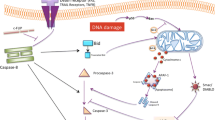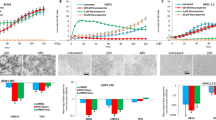Abstract
The number of genes that are up regulated or down regulated during apoptosis is large and still increasing. In an attempt to characterize differential gene expression during serum factor induced apoptosis in AK-5 cells (a rat histiocytoma), we found subunit 6 and subunit 8 of the transmembrane proton channel and subunit alpha of the catalytic core of the mitochondrial F0-F1 ATP synthase complex to be up regulated during apoptosis. The increase in the expression levels of these subunits was concomitant with a transient increase in the intracellular ATP levels, suggesting that the increase in cellular ATP content is a result of the increase in the expression of ATP synthase subunits' gene and de novo protein synthesis. Depleting the cellular ATP levels with oligomycin inhibited apoptosis significantly, pointing to the requirement of ATP during apoptosis. Caspase 1 and caspase 3 activity and the loss of mitochondrial membrane potential were also inhibited by oligomycin during apoptosis in these cells, suggesting that the oligomycin induced inhibition of apoptosis could be due to inhibition of caspase activity and inhibition of mitochondrial depolarization. However, cytochrome C release during apoptosis was found to be completely independent of intracellular ATP content. Besides the ATP synthase complex genes, other mitochondrial genes like cytochrome C oxidase subunit II and III also showed elevated levels of expression during apoptosis. This kind of a mitochondrial gene expression profile suggests that in AK-5 cells, these genes are upregulated in a time-linked manner to ensure sufficient intracellular ATP levels and an efficient functioning of the mitochondrial respiratory chain for successful completion of the apoptotic pathway.
Similar content being viewed by others
Abbreviations
- Annexin V-FITC:
-
fluorescein conjugated annexin V
- TBST:
-
Tris Borate Sodium Tween
- SF:
-
Serum factor
- MRC:
-
mitochondrial respiratory chain
- Dex:
-
Dexamethasone
- DD-PCR:
-
Differential Display PCR
- Act D:
-
Actinomycin D
- CHX:
-
Cycloheximide
- 2-DG:
-
2-deoxyglucose
- DEVD-AMC:
-
Asp-Glu-Val-Asp-7-Amino-4-methylcoumarin
- YVAD-AMC:
-
Tyr-Val-Ala-Asp-AMC
References
Lui HM, Chen J, Wang L, Naumovski L. ARMER, Apoptotic regulator in the membrane of the endoplasmic reticulum, a novel inhibitor of apoptosis. Mol Canc Res 2003; 1: 508–518.
Bjorling Poulsen M, Issinger OG. cDNA array analysis of alterations in gene expression in the promyelocytic leukemia cell line, HL-60, after apoptosis induction with etoposide. Apoptosis 2003; 8: 377–388.
Salvesen GS, Dixit VM. Caspases: Intracellular signaling by proteolysis. Cell 1997; 91: 443–446.
Du C, Fang M, Li Y, Li L, Wang X. Smac, a mitochondrial protein that promotes cytochrome C dependent caspase activation by eliminating IAP inhibition. Cell 2000; 102: 33–42.
Wang X. The expanding role of mitochondria in apoptosis. Genes & Dev 2001; 15: 2922–2933.
Liu X, Kim CN, Yang J, Jemmerson R, Wang X. Induction of apoptotic programme in cell free extracts: Requirement for dATP & cyt C. Cell 1996; 86: 147–157.
Zou H, Henzel WJ, Liu X, Lutschg A, Wang X. Apaf 1, a human protein homologue to C. elegans Ced-4 participates in cytochrome C dependent activation of caspase 3. Cell 1997; 90: 405–413.
Li P, Nijhawan D, Budihardjo I, et al. Cytochrome C and dATP dependent formation of Apaf 1/casp 9 complex initiates an apoptotic protease cascade. Cell 1997; 91: 479–489.
Sakahira M, Enari M, Nagata S. Cleavage of CAD inhibitor in CAD activation and DNA degradation during apoptosis. Nature 1998; 391: 96–99.
Lazebnik YA, Kaufmann SH, Desnoyers S, Poirier GG, Earnshaw WC. Cleavage of poly (ADP-ribose) polymerase by a proteinase with properties like ICE. Nature 1994; 371: 347–348.
Kothakata S, Azuma T, Reinhard C, et al. Caspase 3 generated fragment of selsolin: Effector of morphological change in apoptosis. Science 1997; 278: 294–298.
Kass GEN, Eriksson JE, Weis M, Orrenius S, Chow SC. Chromatin condensation during apoptosis requires ATP. Biochem J 1996; 318: 749–752.
Yasuhara N, Eguchi Y, Tachibana T, Imamoto N, Yoneda Y, Tsujimot Y. Essential role of active nuclear transport in apoptosis. Genes Cells 1997; 2: 55–64.
Matsuyama S, Xu Q, Velours J, Reed JC. The mitochondrial F0-F1 ATPase proton pump is required for function of the proapoptotic protein Bax in yeast and mammalian cells. Cell 1998; 1: 327–336.
Terminella C, Tollefson K, Kroczynski J, Pelli J, Cutaia M. Inhibition of apoptosis in pulmonary endothelial cells by altered pH, mitochondrial function and ATP supply. Am J Physiol Lung Cell Mol Physiol 2002; 283: L1291–L1302.
Stefanelli C, Bonavita F, Stanic' I, et al. ATP depletion inhibits glucocorticoid-induced thymocyte apoptosis. Biochem J 1997; 322: 909–917.
Nicotera P, Melino G. Regulation of the apoptosis-necrosis switch. Oncogene 2004; 23: 2757–2765.
Eguchi Y, Srinivasan A, Tomaselli KJ, Shimizu S, Tsujimoti Y. ATP dependent steps in apoptotic signal transduction. Cancer Res 1999; 59: 2174–2181.
Chandra D, Liu J-W, Tang DG. Early mitochondrial activation and cytochrome C upregulation during apoptosis. J Biol Chem 2002; 277: 50842–50854.
Khar A. Development and characterization of a histiocyte-macrophage tumor cell line. J Natl Cancer Inst 1986; 76: 871–877.
Anjum R, Joshi P, Khar A. Induction of apoptosis in AK-5 tumor cells by a serum factor from tumor rejecting animals: Cytochrome C release independent of Bcl-2 and caspases. Cell Death Differentiation 2001; 8: 1038–1046.
Khar A, Ali AM. Adaptation of rat histiocytoma cells AK-5 to grow in culture. In vitro Cell Dev Biol 1990; 26: 1024–1025.
Liang P, Zhu W, Zhang X, et al. Differential Display using one base anchored oligodT primers. Nucleic Acid Res 1994; 22: 5763–5764.
Gurtu V, Kain SR, Zhang G. Fluorometric and colorimetric detection of caspase activity associated with apoptosis. Annal Biochem 1997; 251: 98–102.
Tang DG, Li L, Zhu Z, Joshi B. Apoptosis in the absence of cytochrome C accumulation in the cytosol. Biochem Biophys Res Commun 1998; 242: 380–384.
Liang P. A decade of differential display. Biotechniques 2002; 33: 338–344, 46.
Sengupta TK, Bandopadhyay S, Fernandes DJ, Spicer EK. Identification of nuclealin as an AU-rich element binding protein involved in Bcl-2 mRNA stabilization. J Biol Chem 2004; 279: 10855–10863.
Lu JY, Schneider RJ. Tissue distribution of AU-rich mRNA-binding proteins involved in regulation of mRNA decay. J Biol Chem 2004; 279: 12974–12979.
Pelletier M, Read CK. RBP16 is a multifunctional gene regulatory protein involved in editing and stabilization of specific mitochondrial mRNAs in Trypanosoma brucei. RNA 2003; 9: 457–468.
Abrams A, Jensen C. Altered expression of H+ ATPase in streptococcus faecalis membranes. Biochem Biophys Res Commun 1984; 122: 151–157.
Kagawa Y, Ohto S. Regulation of mitochondrial ATP synthesis in mammalian cells by transcriptional control. Int J Biochem 1990; 22: 219–229.
Aschenbrenner M, Mueller DM, Zak R, et al. Increased expression of F1 ATP synthase subunits in yeast strains carrying point mutations which destabilize the β subunit. FEBS Letts 1993; 323: 27–30.
Huang H, Li F, Alvarez RA, Ash JD, Anderson RE. Downregulation of ATP synthase subunit 6, cytochrome c oxidase III and NADH dehydrogenase-3 by bright cyclic light in the rat retina. Invest Opthalmol Vis Sci 2004; 45: 2489–2496.
Purring C, Zou H, Wang X, McLendon G. Stoichiometry, free energy and kinetic aspects of cytochrome c:Apaf-1 binding in apoptosis. J Am Chem Soc 1999; 121: 7435–7436.
Drexler HCA. Programmed cell death and the proteasome. Apoptosis 1998; 3: 1–7.
Sanchez-Alcazar JA, Ruiz-Cabello J, Hernandez-Munoz I, et al. Tumor necrosis factor-α increases ATP content in metabolically inhibited L929 cells preceding cell death. J Biol Chem 1997; 272: 30167–30177.
Leist M, Single B, Naumann H, et al. Inhibition of mitochondrial ATP generation by nitric oxide switches apoptosis to necrosis. Exp Cell Res 1999; 249: 396–403.
Rego AC, Vesce S, Nicholls DG. The mechanism of mitochondrial membrane potential retention following release of cytochrome C in apoptotic GT1-7 neural cells. Cell Death Differentiation 2001; 8: 995–1003.
Bossy-Wetzel E, Newmeyer DD, Green DR. Mitochondrial cytochrome C release in apoptosis occurs upstream of DEVD-specific caspase activation and independently of mitochondrial transmembrane depolarization. EMBO J 1998; 17: 37–49.
Marlinou I, Desagher S, Antonsson B, Andre E, Fakan S, Martinou JC. The release of cytochrome C mitochondria during apoptosis of NGF-deprived sympathetic neurons is a reversible event. J Cell Biol 1999; 144: 883–889.
Alcazar SJ, Ault JG, Khodjakov A, Schneider A. Increased mitochondrial cytochrome C levels and mitochondrial hyperpolarization precede camptothecin induced apoptosis in Jurkat cells. Cell Death Differentiation 2000; 7: 1090–1100.
Joshi B, Li L, Taffe BG, et al. Apoptosis induction by a novel anti-prostrate cancer compound BMD 188 (a fatty acid containing hydroxamic acid) requires the mitochondrial respiratory chain. Cancer Res 1999; 59: 4343–4355.
Schultze-Osthoff K, Beyaert R, Vandevoorde V, Haegeman G, Fiers W. Depletion of the mitochondrial electron transport abrogates the cytotoxic and gene inductive effects of TNF-alpha. EMBO J 1993; 12: 3095–3104.
Author information
Authors and Affiliations
Corresponding author
Rights and permissions
About this article
Cite this article
Singh, S., Khar, A. Differential gene expression during apoptosis induced by a serum factor: Role of mitochondrial F0-F1 ATP synthase complex. Apoptosis 10, 1469–1482 (2005). https://doi.org/10.1007/s10495-005-1394-1
Published:
Issue Date:
DOI: https://doi.org/10.1007/s10495-005-1394-1




